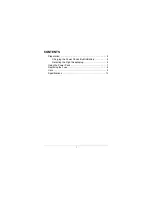
16
JOINTING
(or
EDGING)
Never
edge
a
board
that
is
less
than
3
inches
wide,
less
t
han
1
/4
i
nch
thick,
o
r
12
i
nches
l
ong,
w
ithout
using
a
push
block.
move
fence
forward
to
expose
only
amount
of
cutterhead
required
CAUTION:
When
workpiece
is
twice
the
l
ength
of
the
jointer
infeed
or
outfeed
table
use
an
infeed
or
outfeed
support
.
Begin
by
feeding
stock
with
right
hand
and
apply
pres-
sure
to
front
of
stock
with
push
block.
When
edging,
make
cuts
of
approximately
1/16
inch
for
hardwood
and
1/8
inch
for
softwood.
When
edging
wood
wider
than
3
inches
lap
the
fin-
ers
over
the
top
of
the
wood,
extending
them
back
over
the
fence
such
that
they
will
act
as
a
stop
for
the
hands
in
the
event
of
a
kickback.
Keep
stock
against
the
fence
(Fig.
25).
BEVELING
When
beveling
never
make
cut
deeper
than
1/16
inch.
Make
certain
material
being
beveled
is
over
12
inches
long,
more
than
1/4
inch
thick
and
1
inch
wide.
Set
fence
to
desired
angle.
CAUTION: Although fence may be tilted in or
out for bevel cut, we recommends for safety
reasons the fence b e tilted in, if possible,
making a cradled cut (Fig. 26).
F
Fig. 25
F
Fig. 26
For
wood
wider
than
3
inches,
hold
with
fingers
close
together
near
the
top
of
the
stock,
lapping
over
the
board
and
extending
over
the
fence.
When
beveling
material
less
than
3
inches
wide,
use
beveled
push
blocks
and
apply
pressure
toward
the
fence.
Keep
fingers
near
top
of
push
block
(Fig.
27).
When
beveling
short
material
use
one
bevel
hold
down
and
apply
pressure
toward
the
fence.
Keep
thumb
above
the
ledge
on
hold
down
block
(Fig.28).
CROSS
GRAIN
NOTE:
When
beveling
round
four
edges
of
a
workpiece,
make
cross
grain
cuts
first
.
This
will
help
clean
up
any
chipping
or
splintering
when
beveling
the
end
grain.
For
long
boards,
follow
the
same
hand-over-hand
pro-
cedure
used
for
surfacing
long
boards,
(page
15).
Fig. 27
Fig. 28













































